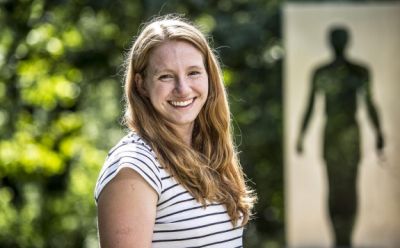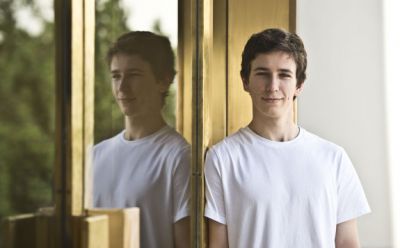The idea to sew face masks came to her long before they were widely needed during the pandemic: more than a year ago Faculty of Arts student Kristýna Šimralová attended a lecture on opportunities for the Deaf, showing how even tough barriers can be overcome. She opted to make face masks with a clear window, allowing the deaf and hard of hearing to see and read lips, in hospitals where masks were worn. Šimralová learned about transparent masks on the internet, when she was researching specialised medical items such as amplified stethoscopes. Making masks was something she wanted to do: all she needed was her own sewing machine. She sewed her first mask last August – a few weeks ahead of the second Covid-19 wave. The student admits that she learned a lot on the fly but her masks are thought through down to the last stitch.
How did things come together? There was a personal reason: Šimralová learned three years ago that she was suffering from hearing loss. Needing to read lips to communicate successfully is something she understands first-hand.
If we go back to that first mask: you had almost no experience sewing, yet you were combining two very different materials: fabric and plastic. Wasn’t that hard?
I have to admit that I had no idea how to approach it at first. I got it in theory (laughs). I had read a lot of recommendations and watched instructional videos. I didn’t want any surprises. But after I made my first mask, I took it to the Tamtam Centre for Children with Hearing Impairment. Seeing a person laugh or smile through the mask, how happy they were, was wonderful. Just as importantly, the plastic folio did not “fog up” which is sometimes the case with such masks.
 That first success convinced me to continue. I decided I would make more and give them to my fellow classmates and friends, in short, to anyone coming into contact with deaf people. I bought a lot of fabric and began making many more.
That first success convinced me to continue. I decided I would make more and give them to my fellow classmates and friends, in short, to anyone coming into contact with deaf people. I bought a lot of fabric and began making many more.
Who got your masks, when they were ready?
My classmates got masks from the first batch at the beginning of September last year. I also offered my masks on facebook and a tutorial to sewing circles, so anyone who wanted could try their hand at it. Overall, my masks were met with positive reactions although there were some who didn’t understand why they were transparent and thought they looked awful. I think they missed the point and even an explanation didn’t help.
How long do you intend to keep it going?
As long as necessary and as long as I can manage. I took 100 masks to Tamtam where I told them I can also offer masks to parents of deaf children and parents who may be deaf themselves. But I’m in my third year at university, so I will have to write my bachelor’s thesis, as well as complete essays and other requirements. But so far I have been able to manage both. By the way, if there’s anyone out there who has extra fabric just lying around they would like to donate, or want to pitch in to buy fabric, that would help a lot. Until now I have covered the costs myself. But if anyone is interested in helping, they can get in touch: This email address is being protected from spambots. You need JavaScript enabled to view it.This email address is being protected from spambots. You need JavaScript enabled to view it.. [Editor's note: you can also look up her tutorial using the QR code].
How long does it take to make a single mask?
I don’t know how long it takes to make a single one but 50 take two days non-stop. I sit down at the sewing machine in the morning and continue until night. Then repeat. Of course, I occasionally get up to stretch or have a bite to eat. The toughest part of the process is making the “windows”. Cutting out the windows – and preparing the plastic folio for sewing – takes three hours alone.
Would you recognise your work easily among other face masks?
Yes. I doubt there would be anything similar from anyone else. I tried to make a bunch of visually different masks which also reflected the season. In the summer, there was an interest in blue masks or floral designs or polka dots. It’s also nice when the mask matches the wearer’s clothes.
When you are not studying – or sewing – what do you enjoy?
I like taking part in diplomacy simulations. These are organised events where participants play different roles: you represent one side of a given issue and try to reach a resolution with different “state representatives”. I used to take part as an organiser, which meant preparing materials for discussions for about 15 team members. The last I did was a Pilsner Diplomatic Simulation. Distance learning in 2020 didn’t leave me much opportunity to take part, so I had to miss it. I also wasn’t sure I would be able to follow every- one because of the face masks. Most participants in such simulations have been people without hearing problems. I know my team members really well and I don’t think it would have been a problem to join, had I wanted.
What do you get out of the experience?
A lot of those who take part are inspirational young people with a broad understanding of issues. I might not look like someone interested in politics but it is also about more than just that. I started taking part in simulations back I high school. My first task was representing Canada and later, at the Prague student summit, Albania in NATO (in English) and later Belgium in the EU. In another simulation, I represented Ethiopia on the United Nations Human Rights Council. In real life, I visited their government website so often for information, they blocked me! They probably thought I was conducting cyber espionage (laughs).
Would you be interested in a career in diplomacy, then?
I want to work as a psychologist for the Deaf, in short, to provide help not only in Czech sign language. I don’t think there are many deaf psychologists for the estimated 500‚000 hard of hearing and 10‚000 deaf people here. Actually, I only know about two. I think it’s very important for a psychologist working with the Deaf to understand the community and culture, to know sign language, to know their needs, and to be able to understand what they are going through.
| Kristýna Šimralová (22) |
|
Student Kristýna Šimralová comes from Sokolov. She is in her third year of Deaf Studies at the Faculty of Arts at Charles University and in her second in Psychology. She enjoys writing, drawing and reading specialised literature. She says she is a perfectionist who won’t quit in the middle of a creative endeavour until it is finished. |






















